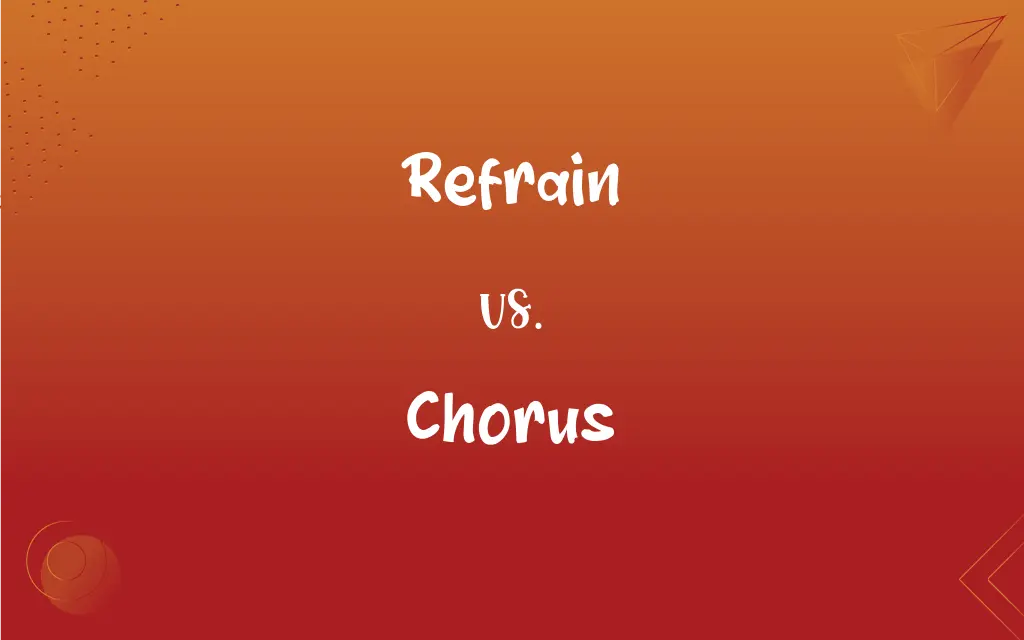Refrain vs. Chorus: What's the Difference?
By Harlon Moss & Janet White || Published on August 11, 2024
A refrain is a repeated line or group of lines in a song or poem, while a chorus is a distinct, repeated section in a song, often featuring the main melody and theme.

Key Differences
A refrain in poetry and music is a repeated line or set of lines, typically at the end of a stanza or verse, that enhances the song's or poem's thematic continuity and emotional resonance. It serves as a recurring motif that emphasizes key themes or sentiments, often encapsulating the essence of the piece. On the other hand, a chorus in a song is a separate, recurring section that usually follows the verse and is characterized by a memorable melody and lyrics that convey the central theme or message of the song. The chorus is designed to be catchy and is often the most recognizable part of a song, encouraging audience participation.
The refrain, due to its repetitive nature, aids in reinforcing the central idea or emotion of a piece, making it more memorable and impactful. It often consists of a phrase or several phrases that are repeated verbatim and can be found in both music and poetry. The chorus, however, is generally more structured and musically distinct from the verses, serving as the climax of a song's narrative or emotional journey. It typically includes the hook of the song, which is designed to stick in the listener's mind.
Refrains are usually integrated within the verses themselves and may not always be immediately distinguishable as a separate entity from the verse. They blend seamlessly with the rest of the song or poem, repeating at specific intervals to create a sense of rhythm and unity. Choruses, in contrast, are clearly differentiated from the verses and often feature a change in musical dynamics, melody, and sometimes even key, making them stand out as a focal point of a song.
The use of a refrain in a piece adds to its lyrical depth and emotional appeal, providing a moment of reflection or emphasis that ties the narrative or thematic elements together. It often serves a poetic function, adding layers to the meaning and enhancing the overall mood. The chorus, with its repetitive and catchy nature, aims to encapsulate the core message of the song in a way that is easily remembered and repeated, often becoming the anthem-like element of the piece.
While both refrains and choruses serve the purpose of repetition and emphasis in music and poetry, their implementation and impact can vary significantly. A refrain's subtlety and poetic integration contrast with the chorus's bold and distinct presence, which often carries the weight of the song's theme and musical identity. Understanding the difference between the two is key to appreciating their roles in enhancing the expressive power and memorability of songs and poems.
ADVERTISEMENT
Comparison Chart
Definition
A repeated line or set of lines within a verse or song.
A distinct, repeated section of a song, usually following a verse.
Function
Emphasizes key themes or emotions and adds lyrical depth.
Highlights the main theme or message with a memorable melody.
Placement
Integrated within verses, often at the end.
A separate section that stands out from the verses.
Musical Role
Enhances thematic continuity and emotional resonance.
Serves as the climax, featuring the main melody and hook.
Memorability
Subtle and poetic, reinforcing the central idea.
Catchy and anthem-like, designed to be easily remembered.
ADVERTISEMENT
Refrain and Chorus Definitions
Refrain
A fixed, repeated phrase that provides a sense of rhythm and unity to a song or poem.
The repeated Let it be in The Beatles' song serves as a lyrical anchor, reinforcing the song's message of acceptance.
Chorus
A section of a song that, through its repetition and memorability, becomes an anthem representing the song's overall message.
The chorus in John Lennon's Imagine acts as an anthem-like element, promoting peace and unity.
Refrain
A tool used in poetry and music to enhance emotional resonance and depth.
The refrain in T.S. Eliot's The Love Song of J. Alfred Prufrock adds to the poem's introspective quality.
Chorus
The part of a song that contains the primary melody and theme, often repeated after each verse.
The chorus in Katy Perry's Firework is designed to be uplifting and memorable, encouraging self-empowerment.
Refrain
A line or group of lines repeated at intervals within a song or poem, contributing to its thematic structure.
The line And miles to go before I sleep in Robert Frost's Stopping by Woods on a Snowy Evening is a classic example of a refrain.
Chorus
A catchy and repeated part of a song that encapsulates its core message and is designed to stick in the listener's mind.
The chorus in Queen's We Will Rock You serves as a powerful and memorable hook that rallies the audience.
Refrain
A repeated element that reinforces the central theme or emotion of a piece.
The refrain Nevermore in Edgar Allan Poe's The Raven emphasizes the theme of loss and longing.
Chorus
The section of a song that encourages audience participation due to its repetitive and catchy nature.
The chorus in Sweet Caroline by Neil Diamond often prompts sing-alongs, making it a popular choice for audience participation.
Refrain
To hold oneself back; forbear from doing something
Refrained from swearing.
Chorus
The part of a song that often serves as the climax, both musically and lyrically, summarizing the song's narrative or emotional journey.
The chorus in Adele's Someone Like You captures the emotional climax of the song, reflecting on lost love and moving on.
Refrain
A phrase, verse, or group of verses repeated at intervals throughout a song or poem, especially at the end of each stanza.
Chorus
A group of singers who perform together, usually singing multi-part compositions with more than one singer for each part.
Refrain
Music for the refrain of a song.
Chorus
A group of vocalists and dancers who support the soloists and leading performers in operas, musical comedies, and revues.
Refrain
A song or melody.
Chorus
A musical composition usually in four or more parts written for a large number of singers.
Refrain
A repeated utterance or theme.
Chorus
A refrain in a song, especially one in which the soloist is joined by other performers or audience members.
Refrain
A line or set of lines that, through repetition, underscores the emotional peak of a piece.
The refrain in Leonard Cohen's Hallelujah serves as an emotional highlight, evoking a sense of spiritual longing.
FAQs
Is a refrain always made up of the same words?
Typically, yes. A refrain usually consists of the exact same words repeated at certain intervals to emphasize a theme or emotion.
How do refrains and choruses enhance audience engagement?
Refrains and choruses engage audiences by providing familiar, repetitive elements that listeners can anticipate and participate in, often becoming sing-along moments in live performances.
What differentiates a refrain from a chorus in a song?
A refrain is a repeated line or set of lines within a verse, while a chorus is a separate, distinct, and often musically different section that repeats throughout the song.
Can a song have both a refrain and a chorus?
Yes, some songs feature both a refrain within the verses and a separate chorus section, each serving different thematic and musical purposes.
Why is the chorus often the most memorable part of a song?
The chorus usually contains the song's main melody and theme, and its repetitive, catchy nature makes it easily memorable and often serves as the song's hook.
How does a refrain contribute to the overall feel of a poem?
A refrain in a poem adds lyrical depth, emotional resonance, and thematic continuity, often encapsulating the essence of the poem's message.
Do all songs need a chorus?
Not all songs have a chorus. Some may rely solely on verses and a refrain, or adopt a non-traditional structure, depending on the songwriter's artistic intent.
What role does a refrain play in storytelling within a song?
A refrain can underscore key moments or themes in a song's narrative, serving as a poetic reminder of the story's core message or emotional undertone.
How does the structure of a refrain differ from that of a chorus?
A refrain is usually a line or set of lines repeated verbatim, while a chorus is a fuller, more developed section with a distinct melody and often more complex lyrics.
Does a refrain have to be at the end of a verse?
While commonly found at the end, refrains can appear at the beginning or even mid-verse, depending on the song's structure and artistic intent.
Can a chorus be instrumental?
While a chorus typically includes lyrics, instrumental choruses exist, especially in instrumental or classical music, where a recurring musical theme serves a similar unifying and thematic role.
Why do some songs use a refrain instead of a chorus?
A refrain can offer a more subtle form of repetition, suitable for songs aiming for a continuous narrative flow or a more poetic, introspective feel.
Can the terms refrain and chorus be used interchangeably?
While they both involve repetition, they serve different structural and musical roles, so they are not typically interchangeable.
How do refrains in poetry compare to those in music?
In both poetry and music, refrains serve to emphasize themes and create rhythmic continuity, but in music, they also contribute to the song's melodic structure.
What impact does a powerful chorus have on a song's popularity?
A powerful chorus can significantly enhance a song's appeal, making it more memorable, engaging, and likely to be shared and sung by audiences.
How do songwriters decide where to place the chorus in a song?
Placement is often determined by the song's narrative structure and the desired emotional arc, with the chorus typically following one or more verses.
How do modern songs reinterpret the traditional roles of refrains and choruses?
Modern songwriters may blend or blur the lines between refrains and choruses, creating innovative structures that challenge traditional norms.
Is the chorus always louder or more dynamic than the verses?
Often, but not always. The chorus is typically more dynamic to highlight its significance, though some songs may use a softer chorus for artistic effect.
What makes a chorus effective in conveying the song's message?
An effective chorus is memorable, emotionally resonant, and encapsulates the song's main message or theme in a way that resonates with listeners.
How do artists vary their choruses to maintain interest?
Artists may introduce variations in melody, lyrics, or instrumentation in repeated choruses to maintain listener interest and add dynamic progression to the song.
About Author
Written by
Harlon MossHarlon is a seasoned quality moderator and accomplished content writer for Difference Wiki. An alumnus of the prestigious University of California, he earned his degree in Computer Science. Leveraging his academic background, Harlon brings a meticulous and informed perspective to his work, ensuring content accuracy and excellence.
Co-written by
Janet WhiteJanet White has been an esteemed writer and blogger for Difference Wiki. Holding a Master's degree in Science and Medical Journalism from the prestigious Boston University, she has consistently demonstrated her expertise and passion for her field. When she's not immersed in her work, Janet relishes her time exercising, delving into a good book, and cherishing moments with friends and family.






































































